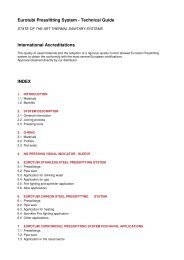Vis PDF - Damstahl
Vis PDF - Damstahl
Vis PDF - Damstahl
You also want an ePaper? Increase the reach of your titles
YUMPU automatically turns print PDFs into web optimized ePapers that Google loves.
Technical<br />
information<br />
Chapter 1: What is Stainless Steel?<br />
Martensitic Stainless Steel<br />
Normally contains 12-16 % Cr, low Ni, rarely Mo and a relatively high content of carbon (C, 0.12-1.2<br />
%). Due to the carbon content, the martensitic steels can be hardened to more than 1000 HV by<br />
rapid cooling, and they are extremely adapt for manufacturing cutting tools, surgical instruments<br />
and high-quality kitchen knives.<br />
Surgical instruments, both made of martensitic stainless steel.<br />
Their mechanical strength is impressive, whereas the corrosion<br />
resistance is low.<br />
After the hardening, the martensitic steel<br />
types can be neither welded nor cold deformed.<br />
Along with any other heat treatment,<br />
welding will cause the steel to lose<br />
its hardness. The martensitic steel types<br />
are strongly magnetic and due to the low<br />
chromium content, the corrosion resistance<br />
is generally poor.<br />
This is the reason why expensive kitchen<br />
knives frequently suffer from superficial pitting<br />
corrosion after a turn in the dish washing<br />
machine.<br />
Ferritic Stainless Steel<br />
Typically, this type contains 12-18 % Cr, low Ni, low carbon (C ≤ 0.12) and sometimes molybdenum<br />
(Mo). The ferritic stainless steel types possess the same metallurgical structure as mild steel;<br />
however, due to the low carbon content, the ferrites are not hardenable. Consequently, the ferrites<br />
are relatively soft, but due to a shorter elongation, they are less adapted to cold deformation than<br />
the soft austenites. All ferritic stainless steel types are strongly magnetic, and the stabilized types<br />
(such as 4512, 4509 and 4521) are weldable.<br />
The lowest alloyed types (i.e. 4003) possess<br />
a relatively poor corrosion resistance,<br />
in particular in strong acids, whereas the<br />
higher alloyed types, such as 4509 and 4521,<br />
equal the well-known 4301 and 4401 with<br />
respect to pitting corrosion and, to a certain<br />
extent, crevice corrosion. Further¬more, the<br />
resistance to wards stress corrosion cracking<br />
is much better than the parallel austenites<br />
(Chapter 4 + 5).<br />
Ferritic stainless steels are very useful for manufacturing thin-walled<br />
specimens without too much welding or bending. This Syrian made<br />
kitchen utensil has been made of 4016 (AISI 430), a very common<br />
steel within catering and a perfect example that it is actually possible<br />
to perform deep-drawing in ferritic stainless steel.<br />
283<br />
www.damstahl.com<br />
01.2013
















